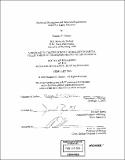| dc.contributor.advisor | David P. Bartel. | en_US |
| dc.contributor.author | Glasner, Margaret E. (Margaret Elyn), 1972- | en_US |
| dc.contributor.other | Massachusetts Institute of Technology. Dept. of Biology. | en_US |
| dc.date.accessioned | 2005-10-14T19:40:09Z | |
| dc.date.available | 2005-10-14T19:40:09Z | |
| dc.date.copyright | 2002 | en_US |
| dc.date.issued | 2003 | en_US |
| dc.identifier.uri | http://hdl.handle.net/1721.1/29289 | |
| dc.description | Thesis (Ph. D.)--Massachusetts Institute of Technology, Dept. of Biology, February 2003. | en_US |
| dc.description | Includes bibliographical references. | en_US |
| dc.description.abstract | The class I ligase, a ribozyme previously isolated from random sequence, catalyzes a reaction similar to RNA polymerization, positioning its 5'-nucleotide via a Watson-Crick base pair, forming a 3',5'-phosphodiester bond between its 5'-nucleotide and the substrate, and releasing pyrophosphate. The class I ligase forms the catalytic domain of an RNA polymerase ribozyme which is capable of extending a primer by 14 nucleotides. The ability of the class I ligase to support RNA-catalyzed RNA polymerization provides support for the RNA world hypothesis, which states that RNA played a more prominent role early in the evolution of life, functioning as both genome and enzymes. In order to determine ways in which catalysis by this ribozyme might be improved and to provide data for an in-depth comparison between the ligase and other ribozymes and protein-enzymes, we characterized the nucleotide triphosphate recognition and metal ion requirements of the class I ligase. Nucleotide recognition by the ligase ribozyme was mediated almost exclusively through Watson-Crick base pairing, endowing the ligase and its derived polymerase with high fidelity. However, primer extension was 100-fold slower than the self-ligation reaction of the parent ribozyme. This rate reduction was traced to the deletion of the second and third nucleotides of the self-ligating ribozyme. When these nucleotides were restored by supplying a trinucleotide substrate, pppGGA, the rate of the reaction was nearly as fast as self-ligation, even though primer extension is a trimolecular reaction. | en_US |
| dc.description.abstract | (cont.) An analysis of the metal ion requirements of the ligase revealed that it has a unique specificity for Mg2+ among ribozymes. In addition, these experiments demonstrated that the ligase is folded in the presence of a variety of metal ions, although its activity is abolished. Finally, these experiments suggested that the ligase may use a mechanism requiring two metal ions, like that of polymerases made of protein. | en_US |
| dc.description.statementofresponsibility | by Margaret E. Glasner. | en_US |
| dc.format.extent | 150 p. | en_US |
| dc.format.extent | 5538742 bytes | |
| dc.format.extent | 5538549 bytes | |
| dc.format.mimetype | application/pdf | |
| dc.format.mimetype | application/pdf | |
| dc.language.iso | eng | en_US |
| dc.publisher | Massachusetts Institute of Technology | en_US |
| dc.rights | M.I.T. theses are protected by copyright. They may be viewed from this source for any purpose, but reproduction or distribution in any format is prohibited without written permission. See provided URL for inquiries about permission. | en_US |
| dc.rights.uri | http://dspace.mit.edu/handle/1721.1/7582 | |
| dc.subject | Biology. | en_US |
| dc.title | Nucleotide recognition and metal ion requirements of an RNA ligase ribozyme | en_US |
| dc.type | Thesis | en_US |
| dc.description.degree | Ph.D. | en_US |
| dc.contributor.department | Massachusetts Institute of Technology. Department of Biology | |
| dc.identifier.oclc | 52291998 | en_US |
